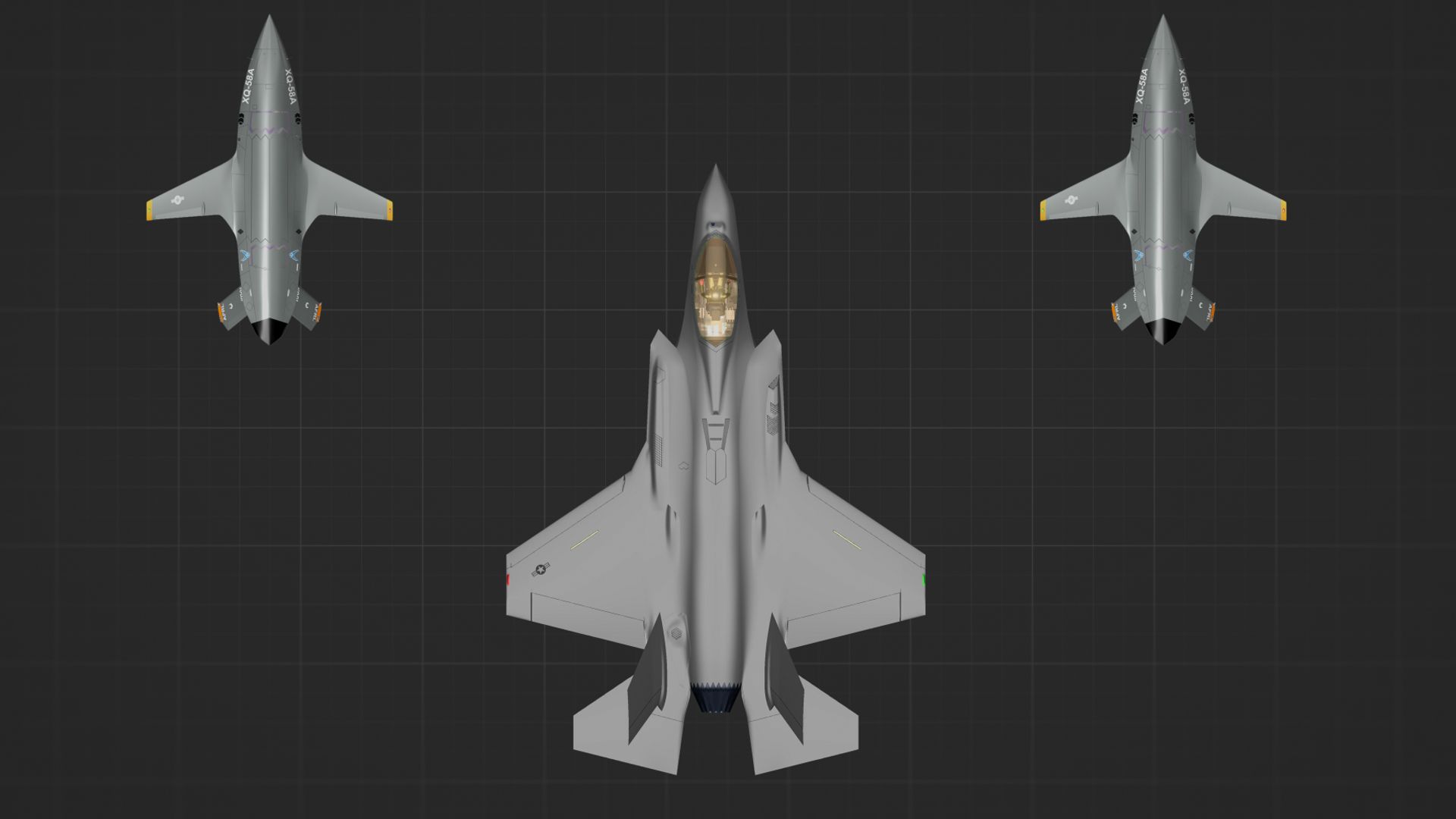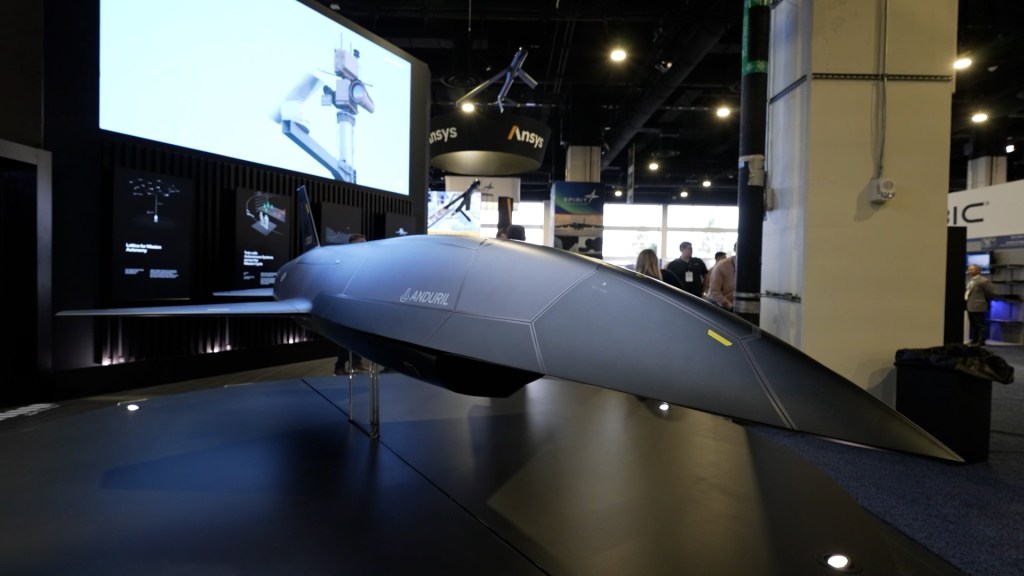
THE UNITED STATES AIR FORCE IS THE OLDEST AND SMALLEST IT’S EVER BEEN. ITS LEADERS ALSO DON’T KNOW WHETHER THE SERVICE HAS THE TIME, MONEY, OR PEOPLE TO PUT ENOUGH PLANES IN THE AIR TO COMPETE WITH AND DEFEAT CHINA. AT LEAST NOT WITHOUT LOSING TOO MANY PILOTS.
THE PROBLEM IS TOO BIG TO SOLVE FOR THE AIR FORCE ALONE. SO, IT’S COLLABORATING WITH THE NAVY, MARINE CORPS AND PRIVATE INDUSTRY TO COME UP WITH THE ANSWER: COLLABORATIVE COMBAT AIRCRAFT OR C-C-A.
THE XQ-58 VALKYRIE FROM KRATOS WAS AN EARLY CANDIDATE INTO THE PROGRAM. IT’S ALSO THE ONLY ONE WITH ANY REAL-WORLD FLIGHT TIME.
Otis Winkler: So, really, it is a fighter-like performance. If you want to think of it as an F-35 without a pilot in it, that’s what you’ve got.
THERE ARE OTHER CCA CANDIDATES IN DEVELOPMENT AS PART OF THE DOD’S OPEN COMPETITION.
THE AIR FORCE, NAVY AND MARINES AGREED TO SOME BASIC FUNDAMENTALS TO SPEED UP DEVELOPMENT AND DELIVERY OF THE CRAFT.
CCAS NEED TO HAVE A COMMON AIRCRAFT ARCHITECTURE AND AUTONOMY ARCHITECTURE. THEY ALSO NEED COMMON COMMUNICATION LINKS AND GROUND-CONTROL SEGMENTS.
BASICALLY, THE SERVICES WANT A STANDARDIZED ROBOTIC PLANE THAT CAN TAKE DIRECTION WELL, WHILE ALSO OPERATING WITH AND TALKING TO OTHER ASSETS IN THE BATTLE SPACE.
INITIALLY, THE LOYAL WINGMEN WILL BE PAIRED WITH F-35s AND WITH THE NEXT GENERATION AIR DOMINANCE FIGHTER ONCE IT’S AIRBORNE.
AIR FORCE SECRETARY FRANK KENDALL SAYS HE WANTS THOUSANDS OF CCAS FLYING WITHIN THE NEXT FIVE YEARS.
Kendall: What we’re trying to get industry to do is to mature technology and be creative. And then demonstrate to us what kind of capability they can provide and why it’s cost effective. And that’s how we’re going to be selecting which ones we carry to the next phase of competition.
THE CCA’S, LIKE A LOT OF MODERN WEAPONRY, ARE DESIGNED WITH MODULARITY IN MIND; MEANING YOU CAN TRADE OUT OR UPGRADE SENSORS AND SOFTWARE ON THE FLY, DEPENDING ON THE MISSION. THIS DISAGGREGATION OF COMPONENTS ALSO HELPS KEEP COSTS DOWN.
THAT’S THE NEXT MAJOR DESIGN FEATURE. THEY’RE SUPPOSED TO BE CHEAP ENOUGH TO SACRIFICE, IF NECESSARY, BUT THEY ALSO NEED TO BE BEEFY ENOUGH TO CARRY OUT THE MISSIONS.
Brig Gen Dale White For me, that’s the challenge, right? Because like, anytime you’re doing something technical, from an engineering perspective, you pull on one thing, you typically lose something else. And so, you end up turning dials to find out where that sweet spot is.
BRIGADIER GENERAL DALE WHITE OVERSEES THE FIGHTERS AND ADVANCED CRAFT PROGRAM FOR THE AIR FORCE. HE AND OTHER GENERALS INVOLVED IN THE CCA PROGRAM SPOKE DURING A MEDIA ROUNDTABLE AT THE AIR AND SPACE FORCES ASSOCIATION’S AIR, SPACE AND CYBER CONFERENCE IN NATIONAL HARBOR MARYLAND.
THESE OFFICERS SAY THEY KNOW PRICE PER UNIT NEEDS TO BE TAKEN INTO ACCOUNT DURING DEVELOPMENT, BUT THERE’S MORE TO COST SAVINGS THAN DOLLARS AND CENTS
Brig General Chris Niemi: If I had a choice to either lose an F-35 with a pilot, or lose an aircraft like a CCA, I’d rather lose the CCA. And so those are the types of tradeoffs that are being enabled with the new technologies that are coming online that frankly, we couldn’t do before.
FOR REFERENCE, NEW F-35s COST MORE THAN $110 MILLION EACH. CCAs WILL NEED TO COST CONSIDERABLY LESS FOR THE PROGRAM TO BE VIABLE. DIGITAL ENGINEERING AND NEW MANUFACTURING METHODS WILL HELP.
ASIDE FROM PRICE, THE NEXT MAJOR CHALLENGE FOR CCAs IS DECIDING HOW MUCH DECISION MAKING POWER, OR AUTONOMY, TO GIVE THEM.
Mike ‘Pako’ Benitez: There is still no Department of Defense definition of autonomy. We’ve been talking about CCA and autonomy for two years, still no definition.
THAT’S MIKE “PAKO” BENITEZ, AN AIR FORCE VETERAN AND THE DIRECTOR OF PRODUCT FOR SHIELD AI, A KEY PLAYER IN THE GROWING FIELD OF AUTONOMOUS PILOTING.
Mike ‘Pako’ Benitez: NATO has a definition. It basically says, ‘I have programmed the thing to do a mission within its constraints, and it can evolve and adapt in the environment without further intervention of a human.’
DECIDING HOW MUCH AUTONOMY TO GIVE CCAs ISN’T EASY, ESPECIALLY WHEN LIVES ARE DEPENDING ON THEIR PERFORMANCE. NOT TO MENTION THE VERY REAL FEAR MANY PEOPLE HAVE AROUND CREATING AI-ENABLED WEAPONRY. IN JUNE, THE INTERNET WAS SET ABLAZE WHEN STORIES OF AN AI-AGENT KILLING ITS OPERATOR STARTED SURFACING. THE INCIDENT TURNED OUT TO JUST BE PART OF A HYPOTHETICAL THOUGHT EXPERIMENT, BUT IT DID SHOW JUST HOW CHARGED OF AN ISSUE THIS IS.
WITH NO FORMAL DEFINITION FROM THE PENTAGON, BENITEZ AND OTHERS IN THE FIELD BORROWED FROM THE SOCIETY OF AUTOMOTIVE ENGINEERS WHEN IT CAME TO DISTINGUISHING BETWEEN LEVELS OF AUTONOMY.
LEVELS RANGE FROM ZERI TO FIVE. ZERO BEING THE LOWEST AND FIVE THE HIGHEST.
LEVEL ONE IS FOR BASIC ASSISTANCE TASKS– THINGS LIKE CRUISE CONTROL IN YOUR CAR.
LEVEL TWO IS PARTIAL AUTOMATION–LIKE A SELF-DRIVING TESLA.
LEVELS THREE AND FOUR ARE WHERE WE SHOULD BE THINKING ABOUT CCAs, BECAUSE THAT’S WHERE CONDITIONAL AND HIGH LEVELS OF AUTONOMY COME INTO PLAY.
Mike ‘Pako’ Benitez: I would argue, Level Three should be the minimum requirement and Level Four is really what we should be shooting for; which is a mission based ‘Here’s your goals. Here’s your objectives. Here’s your risk within those constraints. Execute.’
IT’S UNLIKELY ANY ARMED CCA OR AI-PILOTED DEVICE WILL EVER REACH LEVEL FIVE. BY LAW, THE US MILITARY NEEDS TO HAVE A HUMAN IN THE KILL-CHAIN.
OF COURSE, FIGURING OUT HOW MUCH AUTONOMY TO GIVE A ROBOT PLANE CAPABLE OF CARRYING LETHAL PAYLOADS DEPENDS ON THE TYPES OF SORTIES WE WANT THEM FLYING.
IF THERE ARE AT LEAST TWO CCA’S PER PILOT, LIKE SECRETARY KENDALL SAID, ONE COULD BE A SENSOR CARRIER AND THE OTHER A MUNITIONS MULE. THE FORMER ALLOWS ITS HUMAN PILOT TO SEE TARGETS BEYOND THE HORIZON, THE LATTER CAN DELIVER A KILLING BLOW WITHOUT REVEALING THE PILOT’S POSITION.
BUT HOW DO YOU GET A HUMAN PILOT TO PUT THAT MUCH TRUST INTO A MACHINE?
Mike ‘Pako’ Benitez: It’s just like a radar. If a fighter pilot had never heard of the word ‘radar’, had never had any academics and you gave them a screen and you go ‘Hey, you’re gonna fly around and when these symbols show up on your screen, just trust us. There’s something there, it’s probably going to kill you. It may not, but you should probably do something about it.’ How do you trust what’s on the screen is real? Well, you know because over the years you’ve been indoctrinated with training, you understand radar theory, you get some academics and most importantly, you understand the capabilities, the limitations and the attributes of that algorithm or that hardware and software.
AND THERE’S NO PLACE BETTER TO UNDERSTAND THE CAPABILITIES AND LIMITATIONS OF YOUR WINGMAN, THAN WHEN FLYING WITH THEM, VIRTUALLY OR OTHERWISE.
Brig General Chris Niemi: I’m sure that when the operators start to fly with these and work with them, and test them in different scenarios that it’ll be much clearer what the opportunities are that exist, and maybe some limitations. And then, we’ll react to it, as we have with every other platform.







